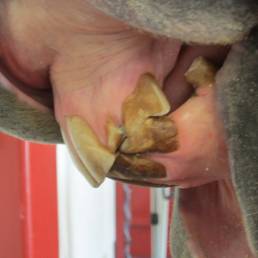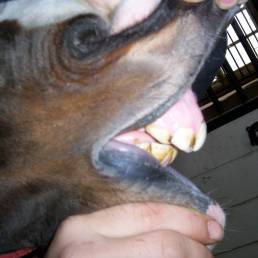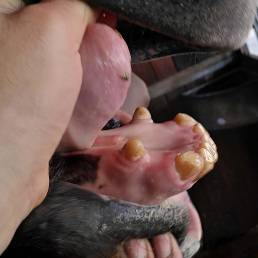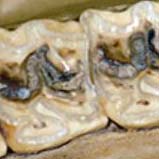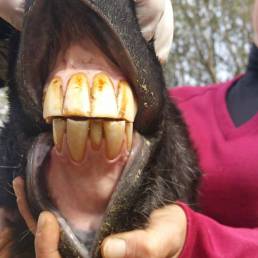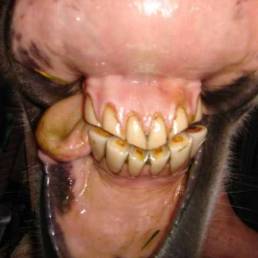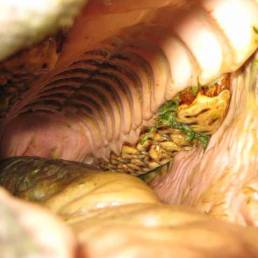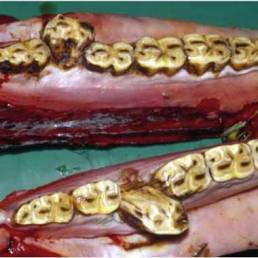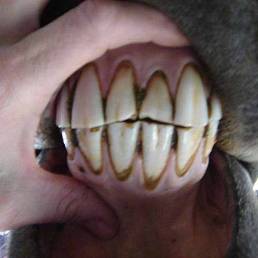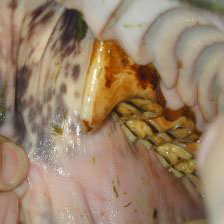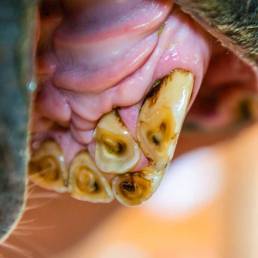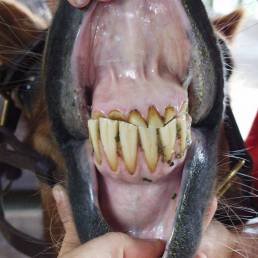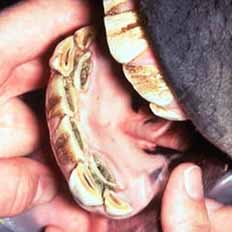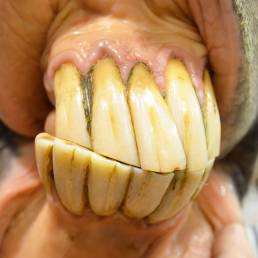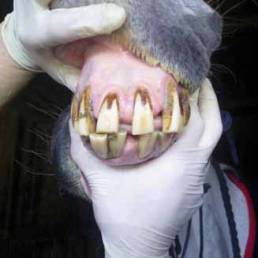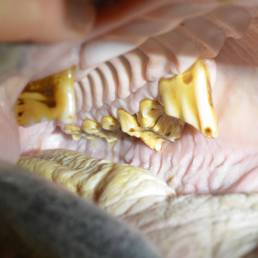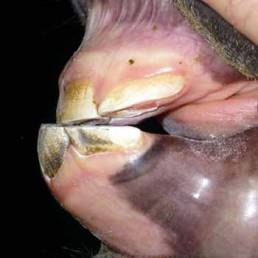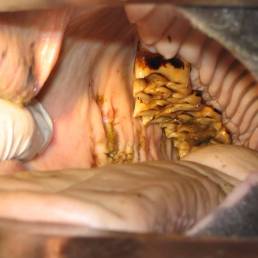Equine Odontology
Dental anatomy and physiology
To understand the pathologies that your horse may suffer and the impact on its health, you must first know the anatomy and function of your horse’s mouth.
The mouth is the first part of the digestive system: it is in the mouth that food is prepared for its digestive journey. The horse is a herbivore that cannot chew its food a second time unlike ruminants: it is essential that it is properly ground in the teeth for the horse to assimilate the nutrients needed for its maintenance.
In the wild, horses eat about 18 hours a day very fibrous and abrasive food. To compensate dental wear, horse teeth grow 2 to 3 mm per year. To grind food, horse’s chewing motion is circular. The dental table (upper) wider than that of the mandible (lower), will erode each other forming dental ridges and tips.
Because the upper and lower arches are not in perfect alignment, wear is uneven: The sharps form on the outside of the maxillary arch (side of the cheek) and on the inside of the mandibular arch. (tongue side).
Composition of a horse’s mouth
The jaw of a horse is anisognata: the upper jaw is about 20% wider than the lower jaw. Horse’s jaws are connected to each other by the temporomandibular joint (TMJ) combined with powerful masticatory muscles. The “fixed” upper jaw is called the maxilla and the “mobile” lower jaw is called the jaw.
To grind their food, horse’s chewing motion is circular. The dental table (upper) is wider than the mandible (lower), therefore, a wear defect of the dental table will appear naturally. Their teeth are hypsodontic: they compensate for the wear on the crown by the eruption of 2 to 3 mm per year.
In adulthood, males usually have 40 teeth compared to 36 in most mares. Fangs are teeth present in males and in 10-20% of mares.
Special features: in some horses a small tooth appears between 6 months and 1 year of age: it is the wolf’s tooth that is found the vast majority of times in the maxilla. These teeth can be annoying or even painful because they are placed in the place where the bit works.
They usually have to be removed before horses are riden and are often already broken at the root due to the chewing process. It is important not to leave sharp pieces of root inside.
The horse’s mouth is made up of: 12 incisors: They cut the grass and take the food (short pasture)
- 4 centrals
Appearance between 0 and 8 days
fall of deciduous teeth around 2 and a half years
- 4 middle
Appearance between 6 and 8 weeks
fall of deciduous teeth at 3 and a half years old
- 4 tips
Appearance between 6 and 8 months
fall of deciduous teeth at 4½ years of age
- 4 canines
Males and 10-20% of females, do not have a baby tooth precursor and appear at 4-6 years of age
- The bars
The empty space between the incisors and premolars is called the “bars”. This space allow horses to temporarily store pieces of food while its molars grind the food.
- 12 premolars and 12 molars
They grind the food. The 1st, 2nd and 3rd premolars are present at birth or appear in two weeks.
Deciduous premolars:
1st premolar 2 and a half years,
2nd premolar 3 years,
3rd premolar 3 and a half years.
Eruption of molars:
At 1, 2 and 3 years of age
The determination of the age of the horse is made according the presence or absence of molars / baby teeth and especially also for the wear of the incisors.
International nomenclature of horse dentition
In order to be able to correctly identify each tooth, an international system has been created. The horse’s head is divided into 4 parts including a set of teeth. Each tooth is numbered for easy identification. Each part of the tooth is also identified in order to facilitate work and communication.
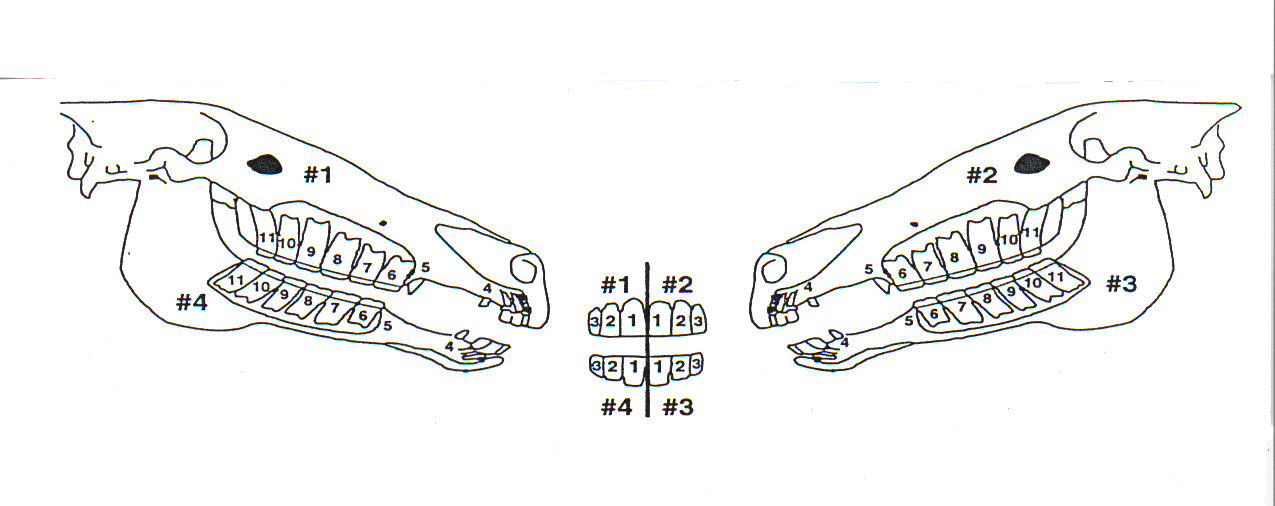
Dental pathologies
Incisors
One of the main dental problems of the horse is due to the lack of continuous grazing. Horses in the wild eat an average of 16 hours a day. In housing conditions, obviously, feeding time is greatly reduced when horses are fed hay rations in the stable.
Hay-fed horses use their lips or incisors only to grab food but not to cut it. This brings us to the main problem. The incisors erupt at a steady rate, but in many stabled horses, the incisors do not wear out at the correct speed as the
most of the time the horse is not eating.
Remember that incisors can be the cause and effect of various dental problems on the teeth. It is also important to note that early intervention, ideally in foals, is essential to detect and correct problems that if left unchecked will worsen and are often irreparable.
Molars
There is a great variability of equine dental problems, most related to the anatomical and dental peculiarities of horses. Remember that horses have hypsodont teeth, ie they compensate for the wear of the dental table by the eruption of the teeth at a rate of 2 to 3 mm / year, and to have anisognathia (ie maxilla · Is about 20% wider than the jaw).
Due to this type of peculiarity, it is common to find problems with enamel tips in the buccal corner in the jaw and lingual in the jaw.
Another peculiarity of horses is the frequent presence of Wolf Teeth
The wolf tooth is at the level of the bars, adjacent to the second premolar. emerges between 6 months and 1 year. Very small compared to other teeth, very sensitive and often placed near the location where the steak works. If the horse is mounted with a fillet or mouthpiece, they may interfere with it and need to be pulled out. There are also wolf teeth under the gums that are usually the most painful.
We also frequently find ramps and hooks that may be in the front or back, top or bottom of the first or last molar. Often the problem occurs when we have a slight advance from the jaw to the jaw.
Because the lower last molar has no 100% contact with the opposite molar, dental growth will often form. And the same for the first upper premolar. The problems are even worse if the horse is pregnant.
The molars naturally have transverse ridges, which are more pronounced when the horses are young. They play an important role in the chewing cycle but excessive transverse ridges can block the movement of the temporomandibular joint and very often cause pain.
The angle of the occlusal surface of the molars is also important and often occurs when a horse eats on one side due to pain or abnormalities in the incisors.
Corrugated dentition is uneven wear of the dental table, in some places creating dominance in several molars. This problem often stems from the lack of maintenance of the teeth when the horse is young.
Sometimes persistent baby teeth also cause a delayed rash or an abnormality in the tooth that precedes them.
Case studies and photo gallery
To be able to appreciate what problems your horse may have it is important to understand what different pathologies may be found.
